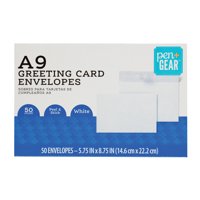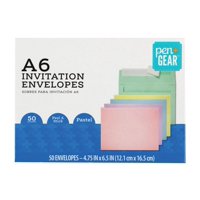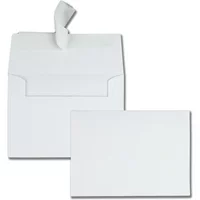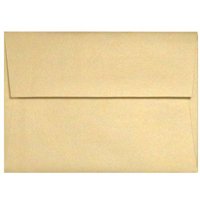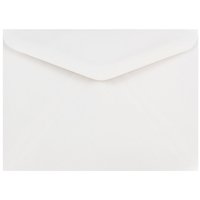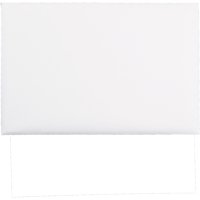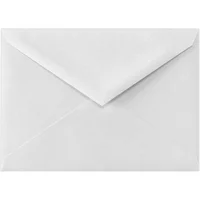Refine by
|Sort by
|- Product Variants SelectorCurrent Price$1795.00$17.95Sold & shipped by Envelopes.comFree delivery
- Current Price$462.00$4.622-day deliveryon orders $35+Free pickup todayGift eligible
- Current Price$289.00$2.892-day deliveryon orders $35+Free pickup todayGift eligible
- Product Variants SelectorCurrent Price$1695.00$16.95Sold & shipped by FineCardstock.comFree delivery
- Product Variants SelectorCurrent Price$1095.00$10.95Sold & shipped by Envelopes.comFree delivery
- Reduced PriceCurrent Price$747.00$7.47Sold & shipped by MyOfficeInnovationsFree delivery
- Product Variants SelectorCurrent Price$21595.00$215.95Sold & shipped by Envelopes.comFree delivery
- Current Price$561.00$5.61Free delivery on orders over $35
- Current Price$1495.00$14.95Free delivery on orders over $35
- Product Variants SelectorCurrent Price$1595.00$15.95Sold & shipped by Envelopes.comFree delivery
Envelopes & mailing supplies
Digital communications may be at the center of many people's lives, but there are still many reasons to send things by mail. Formal invitations for special events, gifts for far-flung relatives and official business communications are just a few of the things that may require you to buy envelopes and other mailing or shipping supplies. Consider these features and options as you decide exactly what supplies you need.
What envelope features should I look for?
Envelopes don't come in just one shape and size, and they can also come with a variety of special features.
- Size: Envelope sizes are sometimes standardized with a combination of numbers and letters, like #10 or A2. If you aren't a regular envelope shopper, look at dimension information for the envelopes you're considering. Taking a look at the overall shape of the envelope may also be helpful for determining whether it's the right size. For example, a long, short envelope may be designed for use with standard-sized printer paper. Double check measurements before buying so you can be sure that you're getting the right size for the papers you're mailing.
- Format: Envelopes may come with special features like security lining, which is an interior printed patterned designed to make it difficult to read what's inside an envelope without opening it. If you ever mail something with sensitive information like a check or a form that has a social security number, look for these special security envelopes to avoid prying eyes. You can also find envelopes that have translucent windows for addresses, which means you'll want to print notices or bills that are formatted specifically to allow important information to show through these openings.
- Closures and adhesives: Most envelopes are self-sealing in some way or another. For standard-sized envelopes, you can find options that close with a no-lick, peel-and-seal sticky adhesive, while others may require that you moisten the adhesive yourself to seal the flap properly. Larger manila envelopes may have gummed adhesive on their flaps in addition to extra closures such as clasps or prongs. If you don't like to lick envelopes but can't find the style you need with a peel-and-seal flap, you can use accessories such as envelope-moistener sponges.
- Color: Envelopes typically come in businesslike colors such as white or, in the case of larger envelopes, an light orange-brown shade. You can find brighter, more attention-getting colors for business mailings or special events, but most envelopes tend to come in duller colors.
What supplies do I need to ship packages?
Whether you're planning on shipping out packages regularly as part of your business or you have one item to send to a friend, it's important to have the right supplies. You'll likely need one item from the first three categories listed here, with the fourth being optional for most people but useful if you ship a lot.
- Containers: Cardboard boxes are among the most popular options for shipping physical goods, though smaller, less-fragile items such as books may be able to ship safely in padded envelopes. Dimensions are an important consideration with cardboard boxes, too. It's often best to know the measurements of the item you're shipping before you buy a box. If the item is at all fragile or liable to get damaged, be sure to leave room in your measurements for packing materials that'll protect the item but also increase its dimensions. You can err on the side of caution and buy a slightly bigger shipping box and fill in any excess with packing materials like paper or bubble cushion wrap. Note that large paper materials such as posters typically do best rolled up and shipped in cylindrical containers.
- Packing materials: From bubble cushion wrap to packing peanuts and paper, packing materials are designed to both cushion and fill in extra space in a shipping box. For especially fragile items, your goal should be not only to wrap the item up but also to prevent it from moving inside its container. This means that simply wrapping an item may not be enough to keep it safe during transport. Filling the entire box with packing materials can help prevent damage.
- Tape: Packing tape has a special design that allows it to stretch tight and stay sealed under pressure. It's also relatively easy to open with scissors or a box cutter. If you're packing something to ship, opt for packing tape rather than tape designed for a different purpose.
- Scales: A postage scale can be important for discerning the exact weight of what you're shipping. This has multiple benefits, including letting you know exactly what postage to pay and avoiding issues with carrier weight restrictions.

